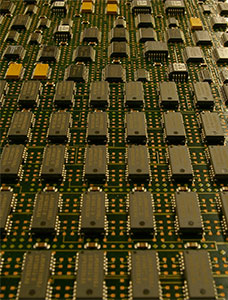3 MIN. READ

For electricians and plumbers trained as recently as the 1970s, lead solder might have been the only option for joining pipes and connecting electronic components. In 1974, U.S. federal law began to target lead solder in plumbing, and by 1986, the Safe Drinking Water Act Amendments effectively banned it in all plumbing used for potable water.
Bans on lead solder came to the electronics industry in 2006, when a European Union (EU) directive banned its use in most consumer electronics devices, with a few limited exceptions. Although the directive only applied to devices sold in the EU, most businesses determined that producing separate products for sale in the EU was impractical.
As a result, these businesses changed the solder used throughout their production lines. Although products using lead solder can still be sold legally in the U.S., more and more products reaching U.S. markets use lead-free solder.
Why was lead solder typically used?
Lead solder was technically an alloy of lead and tin and was sometimes referred to by its chemical formula, Pb-Sn. Lead solder was used heavily for PCB production because it:
- Cools slower than other metals, which reduces the chances of cracking of the joint.
- Wets joints well, which provides a good electrical connection for leads and PCB pads.
- Has a melting point rather than a melting range for the blend used in PCB production, 63% tin and 37% lead, which facilitates automation of PCB production with reflow ovens.
- Has a lower melting point than lead-free alternatives, making it less likely to damage electronic components.
Benefits of lead-free solder
Lead-free solder can include a variety of chemical elements, such as tin, silver, gold, copper, zinc and manganese. One of the most common includes tin, silver and copper and is abbreviated SAC, after the chemical symbols for tin (Sn), silver (Ag) and copper (Cu).
The primary benefit of lead-free solder is that it is safer than lead versions. Lead is a powerful neurotoxin. Although most of the focus on lead poisoning has been on children exposed to lead paint, anyone can suffer from lead poisoning, including electronics assemblers.
Among other benefits, lead-free solder:
- Does not wet as well as lead solders. When connection pins are spaced very close to one another, the reduced wetting prevents solder bridges.
- Creates joints that are harder than lead joints, giving them better mechanical properties.
- Are compatible with existing manufacturing processes for a seamless transition from lead solders.
Drawbacks of lead-free solders
Despite their benefits, lead-free solders are not flawless. In fact, the EU has granted a few exceptions to the lead-free directive to accommodate certain applications. For example, some ceramic capacitors can only be produced using lead solders and are therefore exempt from the EU directive.
Other drawbacks of lead-free solders include:
- Lead-free solders are prone to whiskering, a phenomenon where tin forms electroconductive crystalline structures. Whiskers grow spontaneously in some soldered joints that are high in tin.
- The melting temperature is not as stable, predictable or narrow as that of lead solders, sometimes leading to defects when solder fails to melt completely.
- The melting temperature is higher than that of lead solder, and can damage PCBs and electronic components during manufacture.
Dealing with the change to lead-free solder
The transition to lead-free solder is inevitable. Fortunately, replacement solders provide many of the same properties of lead solder and newer formulations are being developed all the time.
In the meantime, Huntron testing equipment can ensure that your PCBs’ solder joints meet your customers’ specifications. To learn more or schedule a demo, contact us.
Meta Title:
Comparing lead versus lead-free solder for PCBs
Meta Description:
Lead solder will be phased out due to its environmental and health effects. Learn the differences between lead solder and the benefits of lead-free solder for your PCB products.
Meta Keywords:
lead-free solder


2 responses to “Comparing lead vs. lead-free solder for PCBs”
Thank you for the comparison, it has helped as a starting point to my research
Because some of the best soldering stations for beginners have controls that allow you to adjust the power supply to provide even amperage, you do not have to worry about running out of power while working.